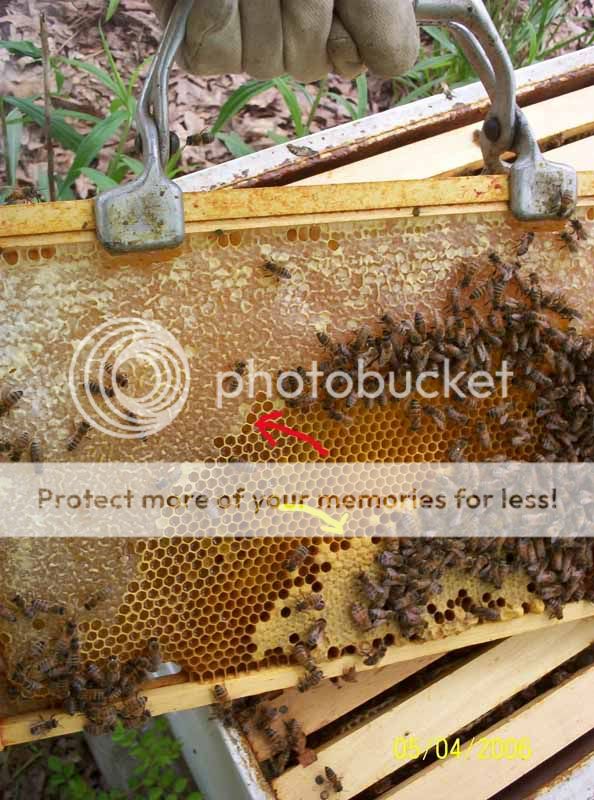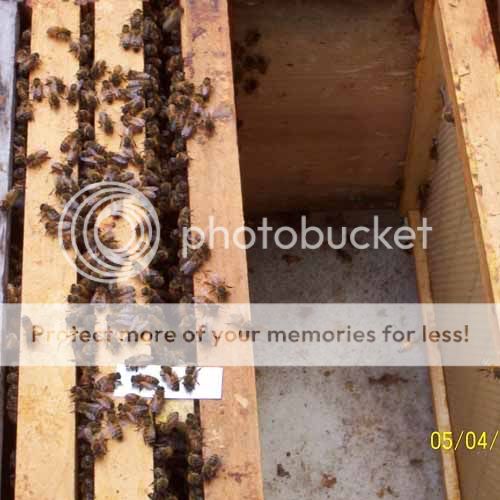Bzzzzzzzzzzzzzzzzzzzzzzzzzzzzzz23:49 May 04 2006
Times Read: 902
So I spent most of the day working in our beehives. Yes, the slightly fuzzy little yellow and black insects that buzz around, chill out on flowers, and have rather unpleasant stings if you swat at one, or accidentally squish one. Potentially deadly, especially if you're one of the many who are allergic to their venom. But, unlike some strains of wasps, hornets, and Africanized honey bees, they won't sting you for no reason. A sting from a honeybee is fatal to the bee. Their stinger is barbed, and when they sting something, the stinger and attached venom glands are ripped out as it flies away.

So while working in the hives today, I decided to take some pictures. I'm posting the pictures in here along with a little information about bees.

This is one of our already established hives. The two larger sections are hive bodies where the queen lays eggs, larvae metamorphisize into honeybees, and where stores of honey and pollen are kept. The top, smaller section is a honey super. This is where excess honey stores are kept, and are the parts of the hive where honey is harvested from.

This is what the inside of each section of the hive looks like. The wooden frames are used to guide the bees into forming their honeycomb into organized easily manageable sections.


This is what the frames look like. In the first picture, the red arrow points to honey cells, and the yellow arrow points to brood cells.


Yes, that's a lot of bees. A healthy hive can easily have up to 50,000 bees.

The smoker, along with the bee suit, caution, and common sense, is used to help keep the bees from becoming aggressive while working in a hive, by overriding pheromones released by bees guarding the entrance of the hive that send warning messages to the rest of the hive. The smoke also helps drive bees away from parts of the hive you're working on.

This week, we were setting up two new hives. Surprisingly enough, the bees get shipped through the mail in these crates. When I went to the post office to pick them up, the whiny kid at the counter wouldn't go back and get them, and made me go outside and around the building to the loading docks that the public isn't supposed to be around to get them.

When setting up a new hive, you take a few frames out of the hive body, remove the small cage containing the queen and hang it between two frames (The small silver strip in that picture), and just dump all the bees out of the cage into the hive. The queen cage has an opening at one end sealed with a candy plug, so she's stuck there for a few days until the bees eat through the candy so she can get free. This is done because the rest of the bees will not leave the queen. If she isn't forced to stay in the hive for a few days while the rest of the bees begin establishing the hive, there is the possibility she will fly away to find somewhere else to build a hive, and all the bees will follow her.

This is the cage the queen is kept in. The yellow arrow points to the queen. I wasn't able to get a clear shot of her, but you can see enough to tell that there's quite a difference in size. After three days, they hadn't eaten all the way through the candy plug, so I had to open the cage and let her out into the hive.

A few interesting facts I found about bees and honey, that I stole from
www.honeybee.com.
A typical beehive houses from 15,000 and 50,000 bees.
There is only one reproductive, the queen, in each hive.
The queen can lay from 1500 to 3000 eggs per day.
The life span of a worker honeybee is only 4 to 6 weeks during the summer, and as many months in the winter.
A bee can produce less than one quarter teaspoon honey in her lifespan.
Man's first alcoholic beverage, Mead is a wine made with honey.
The six sided hex shape of honeycomb is the strongest shape per material weight.
All the bees in the hive are female except the drones.
Utah in the USA, known as the beehive state, has a skep as its state emblem.
Drones, the male bee, make up only about 1/4 of 1% of the hive population
The queen bee can live up to 3 or 4 years.
She mates with from 12 to 20 drones only at the beginning of her life and stores the sperm for continued use.
It takes 8 to 10 pounds of nectar to make a pound of honey.
It takes 8 to 10 pounds of honey to make a pound of beeswax.
To produce a pound of honey, bees travel about 55,000 miles, and visit some 2 million flowers.
The average American consumes about 1.3 lbs. of honey per year.
Approximately 250,000 beekeepers in the USA manage about 3 million colonies.
It takes 21 days from the laying of the egg for the adult worker bee to emerge.
The first duty of an adult worker in the hive is as a nurse bee.
A honeybee can fly about 25 mph (21.7 knots).
One ounce of honey would fuel honeybee flight nearly around world.
Honeybees were called white man's flies by Native American Indians.
They can forage as far as 4 miles from the hive.
Pollen is used as protein by the bees.
Pollen is mixed with honey to make a bread to feed developing larva.
The eggs are the size of a quarter of a grain of rice.
A queen cell has about the size and appearance of a peanut shell.
A queen is fed royal jelly throughout it's development and life span .
A drone, comes from an unfertilized egg, and has no stinger.
Drones do not feed themselves, like the queen, they are fed by worker bees.
The sole function of a drone is to mate with a Virgin queen bee.
Upon mating about 1000 feet up in the air, the drone falls to the ground dead.
Melting at 145 deg. F. beeswax is a natural wax, with the highest burning temp.
The Catholic Church uses one million lbs. of beeswax per year for making candles.
Beeswax is also used in the making of cosmetics and polishes.
Beeswax is an excellent lubricant for sliding doors and windows.
Beeswax is used as a dressing for fan belts and other car parts.
Propolis made from tree sap is used as a glue inside the hive.
Propolis is also used in the pharmaceutical industry.
Bees keep the brood rearing area at about 95 degrees F. and 50% relative humidity.
During hot days the bees bring in drops of water and fan them to cool and humidify the hive.
Bee pollination is vital to maintain the variety of crops this nation enjoys.













COMMENTS
-